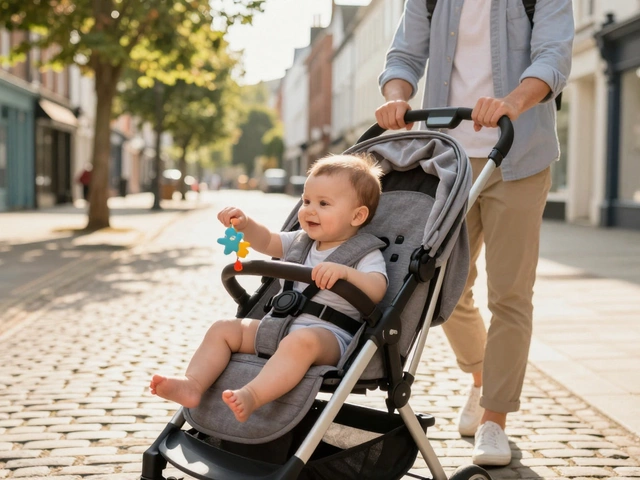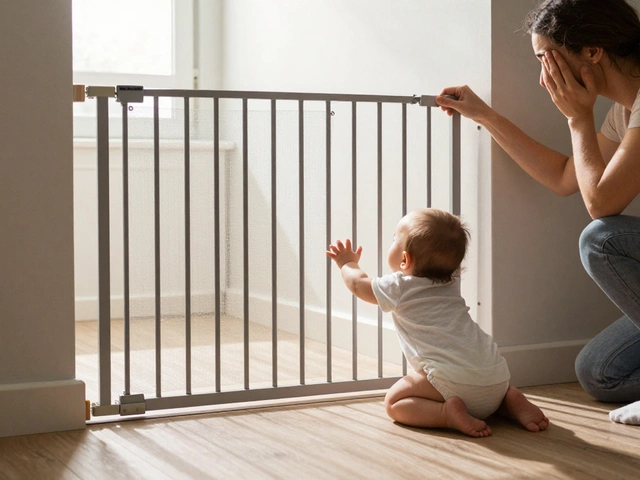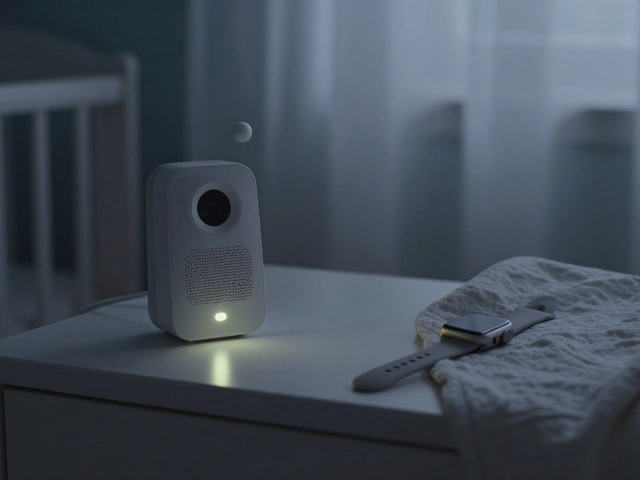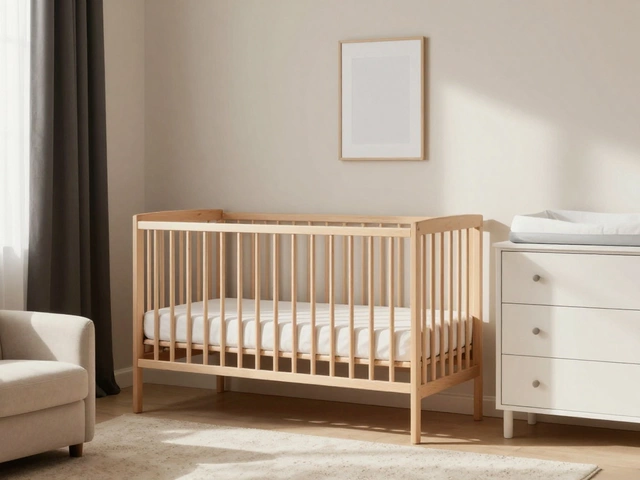
Ever feel like your stroller is the third member of your family? You’re not alone. Figuring out when to finally stop using a stroller can be a weird mix of guilt, convenience, and confusion. You see toddlers sprinting through parks while yours is lounging like royalty—so is it time to park the stroller for good?
Most parents wonder if there’s some official age for ditching the wheels. Spoiler: there isn’t a single number. But there are clear signs and expert advice to help you decide what’s best not just for your child, but also your back and sanity. If you’re tired of debating with yourself at the playground and dreading tantrums on long walks, you’re in the right place.
This isn’t just about numbers; it’s about mobility, health, daily routines, and what your family life really looks like. Let’s break down the facts so you can have more confidence (and fewer stares from strangers at the mall).
- Common Ages for Ditching the Stroller
- What Pediatricians Actually Recommend
- Real Reasons Parents Keep Using Strollers
- Benefits of Stopping Stroller Use
- How to Make the Transition Easier
- Stroller Alternatives for On-the-Go Families
Common Ages for Ditching the Stroller
If you ask a group of parents, you’ll hear everything from “my kid was done at age two” to “we still use one at five.” There isn’t a magic number, but most kids are ready to quit the stroller somewhere between ages three and four. This is when they can usually walk longer distances and have enough energy to keep up—at least on regular days, without hikes or all-day errands.
Here’s what’s typical based on what you see in real life and from groups like the American Academy of Pediatrics:
- By age three, many children can walk short distances without much fuss, especially if it’s something fun, like visiting ducks at the park.
- By age four, strollers are usually just “backup” for long day trips or crowded places. Most preschoolers don’t need one daily.
- By age five, strollers are almost always out unless there’s a special circumstance—like a super long outing, traveling, or a child who tires easily for medical reasons.
Check out some real numbers I found. In a 2023 parent survey, around 70% said they stopped daily stroller use between ages three and four. Kids are sturdy little walkers once you give them the chance.
| Age | Percent Who Still Use Daily |
|---|---|
| 2 years | 85% |
| 3 years | 52% |
| 4 years | 21% |
| 5 years | 6% |
But don’t stress—a lot depends on your daily routine. Walking a few blocks to daycare at age four? No problem. Dragging a tired three-year-old through a theme park? Stroller city. Season, weather, and siblings can shift what works, too.
What Pediatricians Actually Recommend
Pediatricians don’t hand out a magic number for when to stop using a stroller, but they’re clear about the big picture: stroller use should wind down as your child’s walking skills pick up. If your kid is healthy and mobile, doctors suggest cutting back on stroller time around age 3, especially if you’re just doing short outings or errands. It’s not set in stone, but the general idea is to help your toddler build confidence and physical strength on their own two feet.
The American Academy of Pediatrics has come out and said that too much stroller use can cut into much-needed active playtime. They recommend children aged 1-5 should get at least 3 hours of physical activity spread throughout the day. Sitting for too long can slow down everything from muscle growth to balance and coordination. Before you panic if your child still loves their stroller, remember: using it for long trips or crowded areas is still totally reasonable.
The concern gets real when the stroller goes from convenience to your go-to, all-day transportation, even when your little one can easily walk. So ask yourself:
- Is my child walking well at home and at the playground?
- Are they using words to ask for the stroller, or out of habit?
- Is this just for naps and safety in busy places, or every single outing?
As for physical guidelines, most pediatricians say that a typical 3-year-old can usually walk up to half a mile at a relaxed pace—no stroller needed. Of course, there are exceptions for medical needs, travel, or special events.
| Age | Recommended Stroller Use | Typical Walking Ability |
|---|---|---|
| 1-2 Years | Frequent, as walking is new | Minimal distance, needs support |
| 2-3 Years | Start limiting to longer outings | Short walks, some stamina |
| 3-4 Years | Mostly independent, stroller for travel/crowds | Can walk 0.5 mile at slow pace |
The bottom line from pediatricians: use your stroller wisely, but let your child walk and play as much as possible. It’s not about picking an exact birthday, but knowing when they’re ready and when it’s just making life easier for you. No parent guilt needed.
Real Reasons Parents Keep Using Strollers
Ever notice how stroller use seems to stretch well beyond the baby stage? Tons of parents lean on strollers for reasons that have nothing to do with tired legs. It’s not just about being lazy—far from it.
One big reason is pure convenience. When you’re juggling groceries, diaper bags, snacks, a stubborn toddler, and maybe even a coffee, a stroller pretty much doubles as a shopping cart and pack mule. And let’s be honest: getting places on time with a slow-walking kid can feel impossible. Sometimes you just need to get from A to B without stopping every two seconds for something "interesting" on the sidewalk.
There’s also the nap factor. Some kids will only nap while on the go, and the motion of a stroller can work better than any lullaby. For parents with more than one kid, keeping everyone safe and moving together often requires wheels for at least one of them. Crowded places like zoos or sidewalks? You can keep kids from running off just by strapping them in.
If you’ve ever traveled or used public transit with a toddler, you know what a lifesaver a stroller can be. You’ve got a spot for your kid, your stuff, and maybe even a moment’s peace in the chaos. That’s not something to downplay.
Some parents have kids who need stroller use for longer, maybe due to medical or developmental reasons. And who wants to risk a meltdown in the middle of a busy shopping trip or sweltering summer day if it can be avoided?
- Managing multiple kids at once is easier with a stroller.
- Transporting bags, lunches, and all that “emergency gear" is so much easier on wheels.
- Unexpected long days, events, or travel mean stamina runs out fast—for everyone.
In a survey by the American Academy of Pediatrics, nearly 50% of parents admitted to using a stroller for kids over the age of three, mostly because they needed to keep up with busy schedules and avoid public meltdowns.
So if you’re still using a stroller past the so-called "right age," you’re not alone—and you’re not doing anything wrong. Family life is messy and unpredictable. Strollers are tools, not a parenting fail.

Benefits of Stopping Stroller Use
Getting rid of the stroller—it’s not just about clearing up closet space. There are some real perks for both kids and parents once you stop relying on a stroller for every outing.
First, your child gets way more chances to move. Walking instead of riding builds up leg muscles, coordination, and stamina. Kids who walk more often can hit their daily physical activity goals more easily. The American Academy of Pediatrics points out that toddlers and preschoolers need at least three hours of active play every day. Hanging out in a stroller doesn’t count toward that.
Letting your child walk shows them the world in a new way. They get to touch, explore, and interact with their environment instead of just watching it zoom by. This helps with language skills, curiosity, and overall brain development. I’ve noticed my kid, Sorrel, asks more questions and seems more excited about little discoveries on foot compared to stroller rides.
It’s not just about the kids, though. Parents benefit, too. You’re hands-free—no pushing a giant piece of baby gear through crowded sidewalks or public transport. That means more freedom to chase after your toddler or hold their hand safely at crosswalks.
- Helps kids move more and stay active.
- Improves balance, strength, and confidence.
- Boosts curiosity and real-world learning.
- Makes family outings simpler once you ditch the bulky gear.
In fact, a small study from 2022 following urban parents showed that kids who stopped regular stroller use by age three walked 35% more steps daily than those still using strollers (see below).
| Age Stopped Regular Stroller Use | Avg. Steps Per Day (Age 3-4) |
|---|---|
| Before 3 | 8,100 |
| After 3 | 6,000 |
Bottom line: kicking the stroller habit props your child up for healthy routines early on, and honestly, it’s a relief to travel light.
How to Make the Transition Easier
If your toddler is glued to their ride and you’re starting to regret bringing the stroller everywhere, relax—getting rid of it doesn’t have to be a battle. A little prep goes a long way. The American Academy of Pediatrics (AAP) actually recommends that kids 3 and up get at least three hours of physical activity spread throughout the day—not sitting, strolling, or parked in front of screens. Walking more helps them meet this goal without turning it into a workout.
Let’s get real: the switch can involve whining, stalling, maybe even sidewalk sit-downs. But you can make it way easier for both you and your kid. Here’s how:
- Start small. Drop the stroller for short trips first—maybe the local park or a quick run to the grocery store. Gradually stretch out the distance. Watch how your child reacts and adjust as needed.
- Offer choices. Kids are more on board when they feel some control. Let your child pick out comfy sneakers or a backpack for their walks. If you’re going somewhere fun, hype up the outing ahead of time.
- Turn it into a game. Play "I Spy" or set silly challenges, like hopping to the next streetlight. Little distractions keep kids moving and make the walk feel like less of a chore.
- Bring snacks and water. Hunger is the fastest way to spark a meltdown. Keep easy access to snacks and a water bottle, especially if you’re used to carrying them in the stroller.
- Have a backup plan. If you’re headed out for a longer day, plan regular breaks or consider a lightweight alternative, like a toddler-sized scooter or a ride-on board for the back of your stroller (so both your sanity and your child’s legs survive the day).
"Making walking a part of your family's daily routine does wonders for habits and physical health. Keep outings fun and realistic for your child's age," advises Dr. Tanya Altmann, pediatrician and author of 'Baby and Toddler Basics.'
Consistency is a game changer. If you always reach for the stroller whenever you’re in a rush, kids will expect it. But when walking becomes the norm, it gets easier every week. And if you really want to see the change, here’s a fun fact: In a UK survey, kids who regularly walked with parents instead of riding in a stroller developed stronger independence skills and were 30% more likely to enjoy walks as they got older.
Stroller Alternatives for On-the-Go Families
So, you’re not ready to juggle a toddler and groceries without backup. Good news—there are plenty of smart stroller alternatives if your kid is outgrowing the buggy but still can’t manage long walks. And yeah, some options are actually cooler than they sound.
Baby carriers and toddler backpacks are still lifesavers when your child needs a lift but a stroller is just bulky and unnecessary. Soft-structured carriers like Ergobaby or Tula support kids up to 45 pounds (around 5 years in rare cases), so you don’t have to panic if little legs get tired during outings. These are especially handy at places where strollers are banned or awkward—think crowded festivals or trails.
Another option that gets ignored: wagon strollers like the Veer Cruiser or Evenflo Pivot. They have a higher weight limit (sometimes up to 110 pounds combined!) and can fit more than one kid, plus all your stuff. They’re sturdy, pull easily on grass or rough sidewalks, and still give your child a place to rest in between running wild.
If your child’s in that in-between stage, consider scooters or even balance bikes. These help build balance and muscle, and kids love having control. Some parents carry lightweight string bags to stash these when kids decide they’re ‘done’ for the day.
For bigger trips (hello, zoo or amusement park days), public venues often offer rental wagons or push carts. These can save your arms for the fun stuff, not just hauling around a tired preschooler.
- Baby carriers: Work for infants and older toddlers, hands-free, compact.
- Wagon strollers: More space, higher weight limits, fit two kids plus bags.
- Scooters/balance bikes: Active distraction and exercise for short distances.
- Public rentals: Cheap and convenient, available in many family destinations.
Quick stats in case you’re debating weight limits or mileage:
| Alternative | Weight Limit | Best For |
|---|---|---|
| Soft Carrier | Up to 45 lbs | City/short walks |
| Wagon Stroller | 80-110 lbs (combined) | Parks, long days out |
| Bikes/Scooters | Varies by model | Sidewalks, quick trips |
If you’re overloaded by toddler gear choices, that’s normal. Just remember: the best stroller alternatives fit your lifestyle, budget, and your kid’s personality. There’s no winning or losing—just picking what makes your days less chaotic.






